牛津译林版2018八年级上Unit4单元教案
- 格式:doc
- 大小:112.00 KB
- 文档页数:16
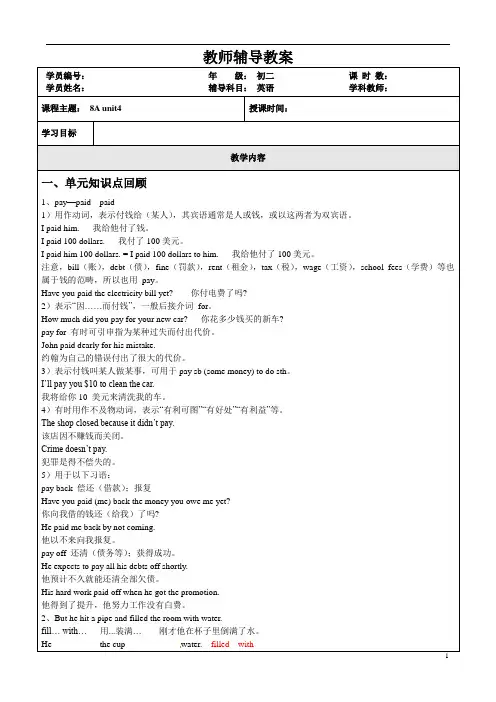
教师辅导教案学员编号:年级:初二课时数:学员姓名:辅导科目:英语学科教师:课程主题:8A unit4 授课时间:学习目标教学内容一、单元知识点回顾1、pay—paid---paid1)用作动词,表示付钱给(某人),其宾语通常是人或钱,或以这两者为双宾语。
I paid him. 我给他付了钱。
I paid 100 dollars. 我付了100美元。
I paid him 100 dollars. = I paid 100 dollars to him. 我给他付了100美元。
注意,bill(账),debt(债),fine(罚款),rent(租金),tax(税),wage(工资),school fees(学费)等也属于钱的范畴,所以也用pay。
Have you paid the electricity bill yet? 你付电费了吗?2)表示“因……而付钱”,一般后接介词for。
How much did you pay for your new car? 你花多少钱买的新车?pay for 有时可引申指为某种过失而付出代价。
John paid dearly for his mistake.约翰为自己的错误付出了很大的代价。
3)表示付钱叫某人做某事,可用于pay sb (some money) to do sth。
I’ll pay you $10 to clean the car.我将给你10 美元来清洗我的车。
4)有时用作不及物动词,表示“有利可图”“有好处”“有利益”等。
The shop closed because it didn’t pay.该店因不赚钱而关闭。
Crime doesn’t pay.犯罪是得不偿失的。
5)用于以下习语:pay back 偿还(借款);报复Have you paid (me) back the money you owe me yet?你向我借的钱还(给我)了吗?He paid me back by not coming.他以不来向我报复。
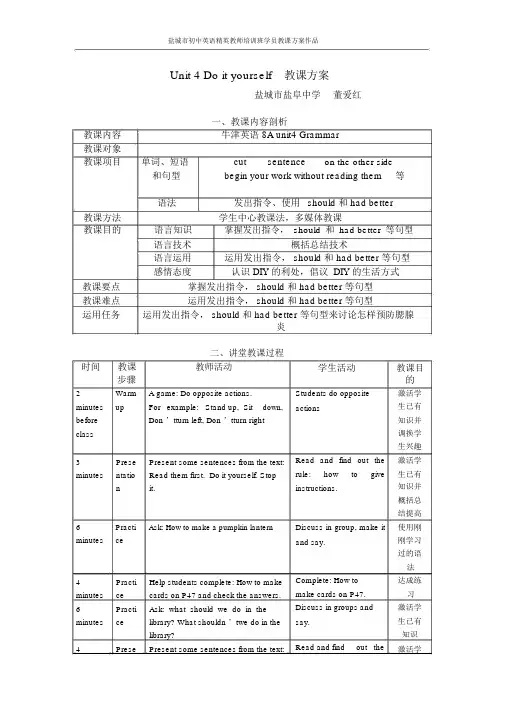
盐城市初中英语精英教师培训班学员教课方案作品Unit 4 Do it yourself教课方案盐城市盐阜中学董爱红一、教课内容剖析教课内容牛津英语 8A unit4 Grammar教课对象教课项目单词、短语cut sentence on the other side和句型begin your work without reading them等语法发出指令、使用should 和 had better教课方法学生中心教课法,多媒体教课教课目的语言知识掌握发出指令,should和had better等句型语言技术概括总结技术语言运用运用发出指令, should 和 had better 等句型感情态度认识 DIY 的利处,倡议 DIY 的生活方式教课要点掌握发出指令, should 和 had better 等句型教课难点运用发出指令, should 和 had better 等句型运用任务运用发出指令, should 和 had better 等句型来讨论怎样预防腮腺炎二、讲堂教课过程时间教课教师活动步骤2Warm A game: Do opposite actions. minutes up For example: Stand up, Sit down, before Don ’tturn left, Don ’tturn right class3Prese Present some sentences from the text: minutes ntatio Read them first. Do it yourself. Stop n it.6Practi Ask: How to make a pumpkin lantern minutes ce4Practi Help students complete: How to make minutes ce cards on P47 and check the answers. 6Practi Ask: what should we do in the minutes ce library? What shouldn ’twe do in thelibrary?4Prese Present some sentences from the text:学生活动Students do oppositeactionsRead and find out therule: how to give instructions.Discuss in group, make itand say.Complete: How tomake cards on P47.Discuss in groups andsay.Read and find out the教课目的激活学生已有知识并调换学生兴趣激活学生已有知识并概括总结提高使用刚刚学习过的语法达成练习激活学生已有知识激活学盐城市初中英语精英教师培训班学员教课方案作品minutes ntatio What should we do? You ’d better get rule: how to use should n some tools.and had better.6Prese Ask: How to be a good student?Discuss in groups and minutes ntatio sayn4Practi Help students complete: DIY advice Complete : DIY advice minutes ce and check the answers.6Prese Ask:How to prevent Mumps( 腮腺Discuss in groups and minutes ntatio炎 )sayn5Exerci Help the students complete the Complete the exercise. minutes se exercise and check the answers.English people like DIY . A lot ofpeople spend their holiday makingtheir homes more b______1______.If there is anything that needsrepairing or decorating around theirhomes, such as p_____2_____thewalls or putting in a new shower, theywill do the jobs themselves. Theys_____3______ DIY experience withtheir friends. More and more peopleshow an i______4_____ in DIY .Sometimes people also DIY in orderto s_____5_____ money. They aretrying to find ways to make theirhouse better when they can’t affordthe c______6_____. So,it ’s notsurprising that DIY is very popular.DIY can be different.People oftenfind it more e______7______ to builda piece of furniture because they can ’tunderstand the instructions well.Sometimes the instructions are simpleand clear,but the furniturei______8_____ is difficult to build.DIY can also be d______9_____.People should learn much about DIYwork before doing it.U______10_____, many people don ’tcare about that. So they may be in 生已有知识并概括总结提高使用刚刚学习过的语法达成练习拓展思维当堂检测盐城市初中英语精英教师培训班学员教课方案作品danger.1Home Say: Finish some exercises.minute work三、教课反省教课反省。
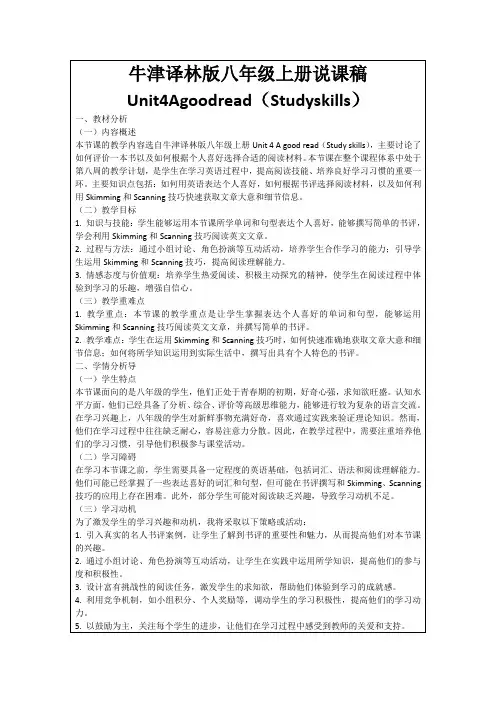
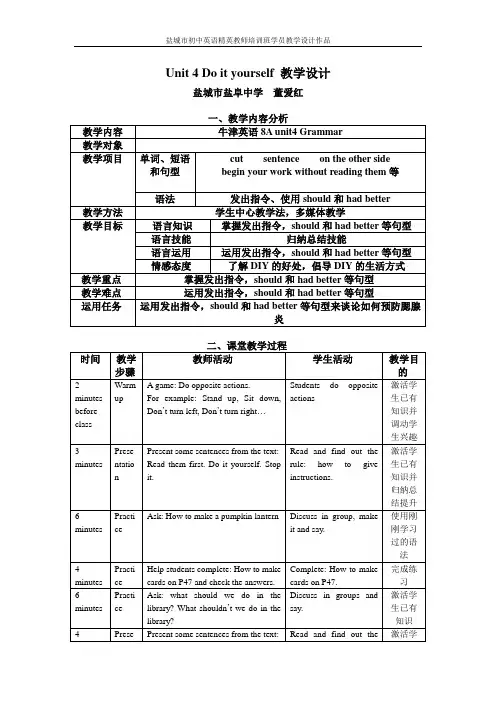
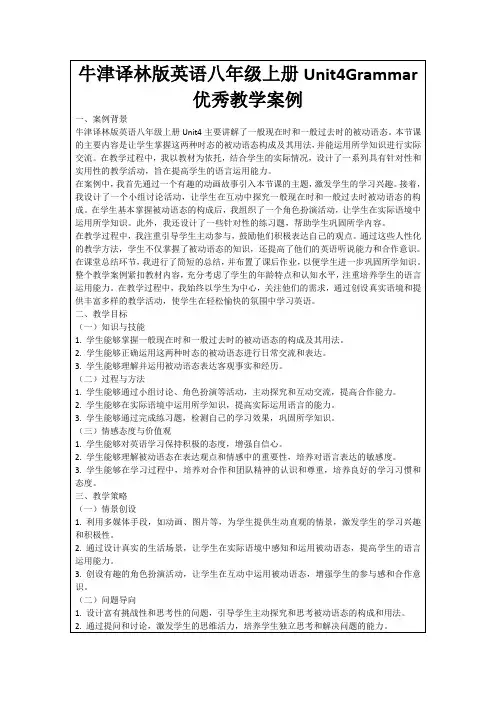
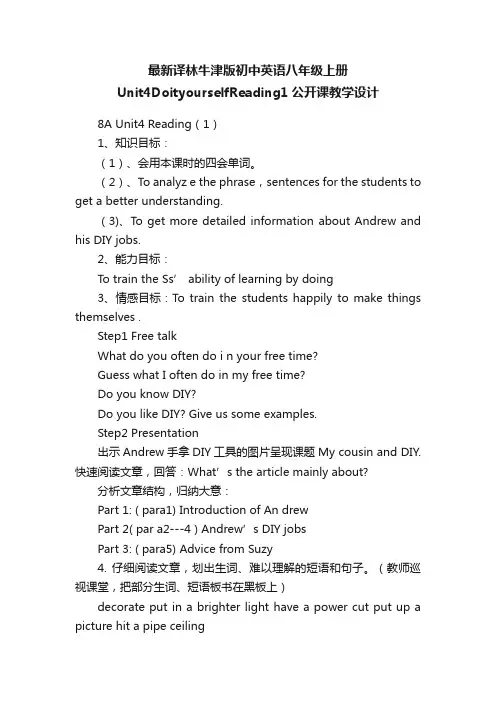
最新译林牛津版初中英语八年级上册Unit4DoityourselfReading1公开课教学设计8A Unit4 Reading(1)1、知识目标:(1)、会用本课时的四会单词。
(2)、To analyz e the phrase,sentences for the students to get a better understanding.(3)、T o get more detailed information about Andrew and his DIY jobs.2、能力目标:To train the Ss’ ability of learning by doing3、情感目标:To train the students happily to make things themselves .Step1 Free talkWhat do you often do i n your free time?Guess what I often do in my free time?Do you know DIY?Do you like DIY? Give us some examples.Step2 Presentation出示Andrew手拿DIY工具的图片呈现课题My cousin and DIY. 快速阅读文章,回答:What’s the article mainly about?分析文章结构,归纳大意:Part 1: ( para1) Introduction of An drewPart 2( par a2---4 ) Andrew’s DIY jobsPart 3: ( para5) Advice from Suzy4. 仔细阅读文章,划出生词、难以理解的短语和句子。
(教师巡视课堂,把部分生词、短语板书在黑板上)decorate put in a brighter light have a power cut put up a picture hit a pipe ceilingtake a course in DIY attend le ssons instead通过生生之间、师生之间的互动解决难题。
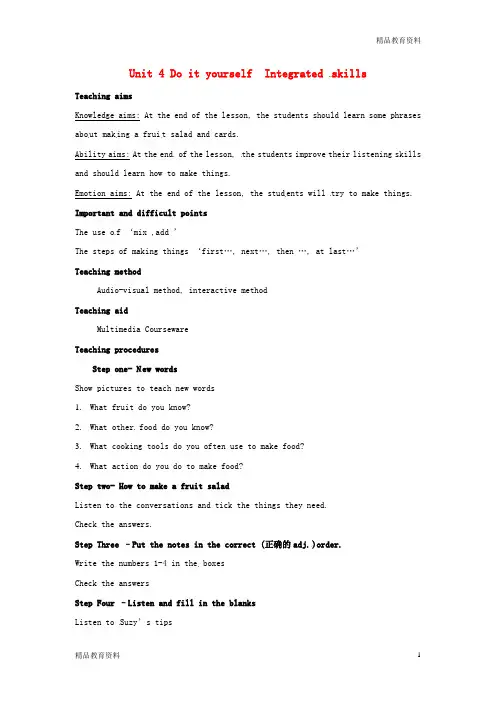
精品教育资料Unit 4 Do it yourself Integrated skillsTeaching aimsKnowledge aims: At the end of the lesson, the students should learn some phrases abo ut mak ing a frui t salad and cards.Ability aims: At the end of the lesson, the students improve their listening skills and should learn how to make things.Emotion aims: At the end of the lesson, the stud ents will try to make things. Important and difficult pointsThe use o f ‘mix ,add ’The steps of making things ‘first…, next…, then …, at last…’Teaching methodAudio-visual method, interactive methodTeaching aidMultimedia CoursewareTeaching proceduresStep one- N ew wordsShow pictures to teach new words1.What fruit do you know?2.What other food do you know?3.What cooking tools do you often use to make food?4.What action do you do to make food?Step two- How to make a fruit saladListen to the conversations and tick the things they need.Check the answers.Step Three –Put the notes in the correct (正确的adj.)order.Write the numbers 1-4 in the boxesCheck the answersStep Four –Listen and fill in the blanksListen to Suzy’s tips精品教育资料Check the answers.Step Five- Important phrases1.mix sth and sth2.add sth to sth3.cut … into…4.get sth ready5.tips for sth/ doing sth6.make sure7.for exampleStep Six – Speak up1.Ask two questions,2.Read the dialoguenguage pointsStep Seven – Homework1.Try to make a kind of food.2.Remember all the things we need to make food.Feedback:。
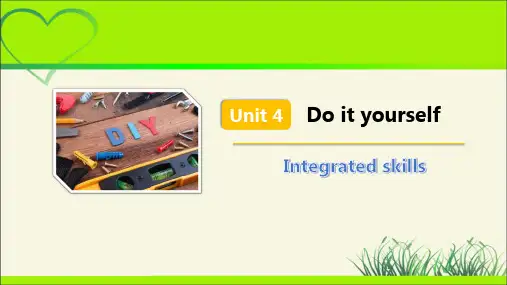
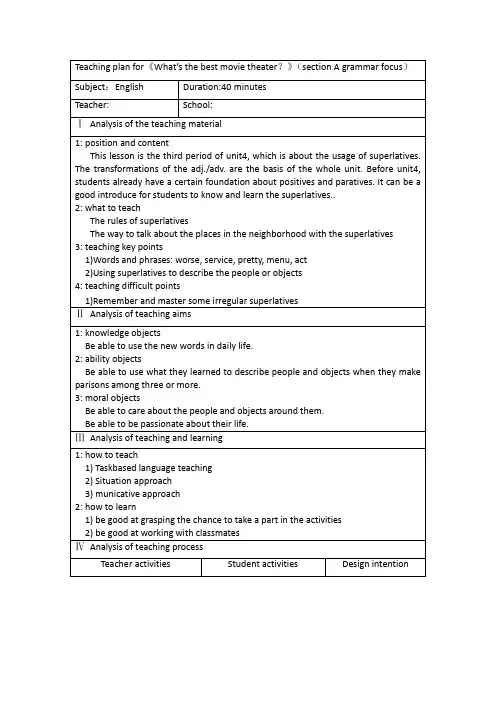
1: Before classAsk students to collect some basic information about the restaurant around their homes, such as the price of food, the distance from their homes, qualities of food…2:While classStep1: warming up Teacher leads students to go over 2d and the article feature.Teacher leads students to think about what’s important in the neighborhood.Step2:Teacher leads students make a list of important places in the neighborhood. Teacher shows some qualities of movie theater and leads students to think of the qualities of other places.Step3:Teacher makes a conversation with one of the students.Teacher leads students to make a similar conversation in two. Collect from the internet orgo out to ask about therelevant information.Review the frame of article.Think about what’simportant in theneighborhood.First, answer the questions.Secondly, discuss withgroup members aboutqualities of other places.Pair work:Students makeconversations in pairs to talkabout the qualities of theimportant places in the通过收集餐馆的信息,让学生体会到学习与生活的交汇有无穷乐趣,为本课的最后任务做铺垫。
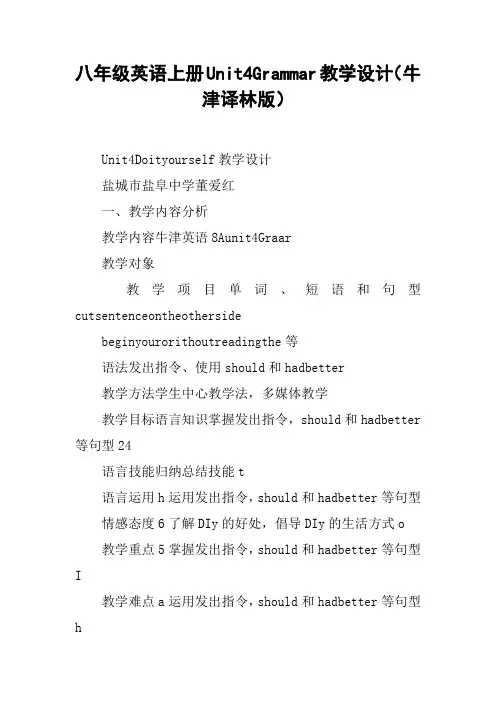
八年级英语上册Unit4Grammar教学设计(牛津译林版)Unit4Doityourself教学设计盐城市盐阜中学董爱红一、教学内容分析教学内容牛津英语8Aunit4Graar教学对象教学项目单词、短语和句型cutsentenceontheothersidebeginyourorithoutreadingthe等语法发出指令、使用should和hadbetter教学方法学生中心教学法,多媒体教学教学目标语言知识掌握发出指令,should和hadbetter 等句型24语言技能归纳总结技能t语言运用h运用发出指令,should和hadbetter等句型情感态度6了解DIy的好处,倡导DIy的生活方式o教学重点5掌握发出指令,should和hadbetter等句型I教学难点a运用发出指令,should和hadbetter等句型h运用任务P运用发出指令,should和hadbetter等句型来谈论如何预防腮腺炎6二、课堂教学过程时间教学步骤6教师活动8学生活动Z教学目的2inutesbeforeclass4arup0Agae:Dooppositeactions.A Forexaple:Standup,Sitdon,Don’tturnleft,Don’tturnright…fStudentsdooppositeactionsA激活学生已有知识并调动学生兴趣=inutes=PresentationPresentsoesentencesfrothetext:Readthefirst.Doityourself.Stopit.Readandfindoutther ule:hotogiveinstructions.激活学生已有知识并归纳总结提升inutesPracticeAs:HotoaeapupinlanternDiscussingroup, aeitandsay.使用刚刚学习过的语法inutesPracticeHelpstudentsplete:HotoaecardsonP47and chectheansers.plete:HotoaecardsonP47.完成练习inutesPracticeAs:hatshouldedointhelibrary?hatshouldn’tedointhelibrary?Discussingroupsandsay.激活学生已有知识inutesPresentationPresentsoesentencesfrothetext:hatshouldedo?you’dbettergetsoetools.Readandfindouttherule:hotousesho uldandhadbetter.激活学生已有知识并归纳总结提升inutesPresentationAs:Hotobeagoodstudent?Discussingroupsandsay使用刚刚学习过的语法inutesPracticeHelpstudentsplete:DIyadviceandchecthe ansers.plete:DIyadvice完成练习inutesPresentationAs:HotopreventupsDiscussingroupsandsay拓展思维inutesExerciseHelpthestudentspletetheexerciseandche ctheansers.EnglishpeoplelieDIy.Alotofpeoplespendtheirholidayai ngtheirhoesoreb______1______.Ifthereisanythingthatn eedsrepairingordecoratingaroundtheirhoes,suchasp_____2_____theallsorputtinginaneshoer,theyilldothejobstheselves.Theys_____3______DIyexperienceiththeirfri ends.oreandorepeopleshoani______4_____inDIy.Soeties peoplealsoDIyinordertos_____5_____oney.Theyaretryin gtofindaystoaetheirhousebetterhentheycan’taffordthec______6_____.So,it’snotsurprisingthatDIyisverypopular.DIycanbedifferent.Peopleoftenfinditoree______7_____ _tobuildapieceoffurniturebecausetheycan’tunderstandtheinstructionsell.Soetiestheinstruction saresipleandclear,butthefurniturei______8_____isdif ficulttobuild.DIycanalsobed______9_____.Peopleshoul dlearnuchaboutDIyorbeforedoingit.U______10_____,any peopledon’tcareaboutthat.Sotheyaybeindanger.pletetheexercise.当堂检测inuteHoeorSay:Finishsoeexercises.三、教学反思教学反思。
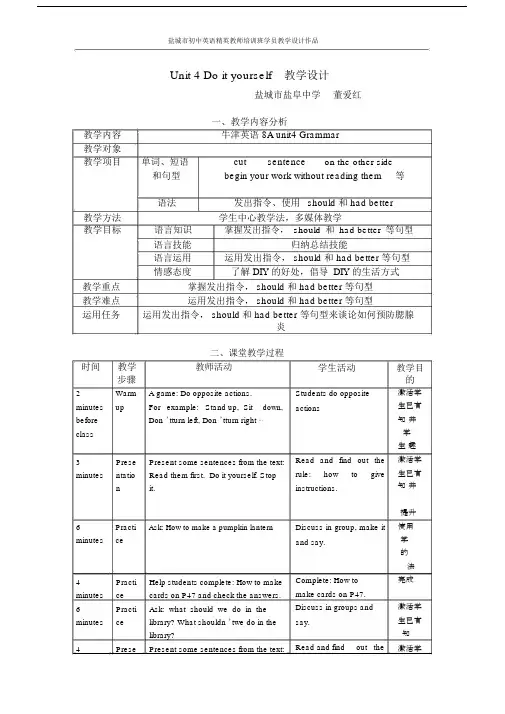
盐城市初中英语精英教师培训班学员教学设计作品Unit 4 Do it yourself教学设计盐城市盐阜中学董爱红一、教学内容分析教学内容牛津英语 8A unit4 Grammar教学对象教学项目单词、短语cut sentence on the other side和句型begin your work without reading them等语法发出指令、使用should 和 had better教学方法学生中心教学法,多媒体教学教学目标语言知识掌握发出指令,should和had better等句型语言技能归纳总结技能语言运用运用发出指令, should 和 had better 等句型情感态度了解 DIY 的好处,倡导 DIY 的生活方式教学重点掌握发出指令, should 和 had better 等句型教学难点运用发出指令, should 和 had better 等句型运用任务运用发出指令, should 和 had better 等句型来谈论如何预防腮腺炎二、课堂教学过程时间教学教师活动步骤2Warm A game: Do opposite actions. minutes up For example: Stand up, Sit down, before Don ’tturn left, Don ’tturn right ⋯class3 Prese Present some sentences from the text: minutes ntatio Read them first. Do it yourself. Stop n it.6Practi Ask: How to make a pumpkin lantern minutes ce4 Practi Help students complete: How to make minutes ce cards on P47 and check the answers.6 Practi Ask: what should we do in the minutes ce library? What shouldn ’twe do in thelibrary?4 Prese Present some sentences from the text:学生活动Students do oppositeactionsRead and find out therule: how to give instructions.Discuss in group, make itand say.Complete: How tomake cards on P47.Discuss in groups andsay.Read and find out the教学目的激活学生已有知并学生趣激活学生已有知并提升使用学的法完成激活学生已有知激活学盐城市初中英语精英教师培训班学员教学设计作品minutes ntatio What should we do? You ’d better get rule: how to use should n some tools.and had better.6Prese Ask: How to be a good student?Discuss in groups and minutes ntatio sayn4 Practi Help students complete: DIY advice Complete : DIY advice minutes ce and check the answers.6 Prese Ask: How to prevent Mumps( 腮腺Discuss in groups and minutes ntatio 炎 ) sayn5 Exerci Help the students complete the Complete the exercise. minutes se exercise and check the answers.English people like DIY . A lot ofpeople spend their holiday makingtheir homes more b______1______.If there is anything that needsrepairing or decorating around theirhomes, such as p_____2_____ thewalls or putting in a new shower, theywill do the jobs themselves. Theys_____3______ DIY experience withtheir friends. More and more peopleshow an i______4_____ in DIY .Sometimes people also DIY in orderto s_____5_____ money. They aretrying to find ways to make theirhouse better when they can’t affordthe c______6_____. So, it ’s notsurprising that DIY is very popular.DIY can be different. People oftenfind it more e______7______ to builda piece of furniture because they can ’tunderstand the instructions well.Sometimes the instructions are simpleand clear, but the furniturei______8_____ is difficult to build.DIY can also be d______9_____.People should learn much about DIYwork before doing it.U______10_____, many people don ’tcare about that. So they may be in 生已有知识并归纳总结提升使用刚刚学习过的语法完成练习拓展思维当堂检测盐城市初中英语精英教师培训班学员教学设计作品danger.1Home Say: Finish some exercises.minute work三、教学反思教学反思。
Unit 4 Do it yourself 教学设计教学内容牛津英语8A unit4 reading 1 教学对象教学项目单词、短语和句型crazy be crazy about terrible once put in mistake make a mistake power cut pipe fill fill with等课文一篇最新DIY的文章教学方法学生中心教学法,多媒体教学教学目标语言知识掌握最新DIY方面的词汇和句型语言技能略读和详读技巧语言运用熟练运用DIY方面的词汇和句型情感态度了解DIY的好处,倡导DIY的生活方式教学重点略读和详读技巧教学难点略读和详读技巧运用任务运用DIY方面的词汇和句型来复述Andrew的DIY故事时间教学步骤教师活动学生活动教学目的2 minutes before class WarmupShow their DIY jobs fortheir parents.引起学生对于DIY的兴趣2 minutes FreetalkAsk:What kind of DIY jobs do you oftendo in your free time?Have a talk. 激活学生已有知识2 minutes PresentationEncourage Ss to predict according to the title and a picture of Andrew:What will the article tell us?Look at the title and thepicture and predict.读前进行合理预测2 minutes SkimmingHelp Ss work out the article structure. Ss work out the article structure.Part1 (Para. 1):Introduction of AndrewPart2 (Para. 2-4):Andrew’s DIY jobsPart3 (Para. 5): Advicefrom Suzy略读并理清文章结构2 minutes ScanningHelp students read and complete theintroduction.Read Part1 (Para. 1)Complete Introduction详读第一部分并找出文章的Who What How Andrew DIY terrible 人物事件和结局8 minutes ScanningHelp students read and say Andrew’sDIY jobs and the problems he caused.Read Part2 (Para. 2-4)and say Andrew’s DIYjobs and the problemshe causedPutting in a brighterlight: The whole househad a power cut.Putting up a picture: Hehit a pipe and filled theroom with water.Painting the living room:Now the living room hasnot only blue walls butalso a blue ceiling andfloor. Even his cat isblue now!Putting up a shelf: Thebooks couldn’t staythere because one end ofthe shelf was muchheavier than the other.详读第二部分并找出发生的四个事件以及每个事件的结局6 minutes DiscussionAsk: What DIY jobs did you do toyour house? Did you have anyproblems?Discuss in groups andshare their experiences.结合课文让学生谈谈自身经历2 minutes ScanningHelp students read and find out:Who did these?attended lessons every Saturday;advised…to take a course; said “Ialready know everything about DIY”;bought books about DIY; read all thebooks; got angryRead Part3 (Para. 5) andthink:Suzy: attended lessonsevery Saturday; read allthe books; advised …to take a course; boughtbooks about DIY.Andrew: said “I alreadyknow everything aboutDIY”; got angry.详读第三部分并找出整个的文章结局6 minutes DiscussionAsk: What should we do when we doDIY jobs?Discuss in groups andsay: we should readmore books, …….拓展思维3 minutes PracticePlay the tape. Read after the tape.Read by themselves.纠正语音语调并熟练朗读6 minutes PracticeHelp students retell the article. Retell the article withthe help of the keywords: crazy; terrible;put in a brighterlight; ……通过复述文章加深对文章的理解5 minutes ExerciseHelp the students complete theexercise and check the answers.Today the DIY is very popular amongus. It is very n______1_____ andfashionable. In my opinion, I believeit is a very good thing. First, it cang______2_____ us a real experience(经历)in doing something orm______3_____ something and thisexperience is important. Second, it isa good way to express(表达)ouri______4_____, and we can realizeour ideas by DIY. Fore______5_____, we can make a cakeor dish with our o______6_____ideas. Third, we can e______7_____ourselves and get the s______8_____of achievement(成就)by doing DIY.Finally, DIY is a good way to reduce(减少)the c______9_____ when wemake something. All in all, it is verygood and suitable for manyy______10_____ students.Complete the exercise. 当堂检测1 minute HomeworkSay:Write about your own DIY stories. Let’s share them next class.教学反思。
牛津译林版2018八年级上册教案 1 课 题 8A Unit 4 Welcome to this unit 课型 New
教学目标 To learn about the names of common tools. To talk about DIY in English.
教学重点 Useful expression 教学难点 To talk about DIY in English 教学过程 教 师 内 容 备 课 札 记 Comic strip Step1 Presentation 1.1.Have a free talk: There’s something wrong with my computer. I’m going to fix it today. I’m going to do some DIY work. Do you know what DIY stands for? Write “stand for” on Bb. 2. Ask: When you do DIY work, you do things yourself. Can you do any DIY work? What can you do? Step 2 Listening 1. Show the pictures of Hobo and Eddie without r the script, say: Look at these pictures, please. Hobo has some work to do today. Do you think Eddie will help him? 2. Say: Now let’s listen to the dialogue between Eddie and Hobo. Please answer some questions after listening. Play the tape. What’s Hobo going to do? What should Hobo do first? What does Hobo probably need? Step 3 Activities 1. Say: Now open your books. Let’s repeat Eddie and Hobo’s dialogue after the tape. Pay attention to your pronunciation and intonation. 2. After reading, T: Well done! Now let’s work in pairs and act out the dialogue. You can add your own ideas. 3. Walk around the classroom and invite several pairs to act out in front of the classroom. T: Ok, some of you will come to the front and act out your dialogue. Praise students: Good job!/Well done! Welcome to the unit Step 1 Presentation 1. T: Hobo has to build his new house on his own. He needs some tools. What tools do you think he needs? Give some hints: I think he needs a hammer to hit nails 牛津译林版2018八年级上册教案 2 with./I think he needs a screwdriver to put all the parts together./… 2. Ask students to turn to page 43, T: Please open your books. Look at the young man in this picture. He loves DIY a lot./He has lots of tools. Lead the reading and explain the words. Ask ss to complete Part A. 3. Ask ss to to talk about the use of these tools: Boys and girls, do you know what these tools are used for? Step 2 Activities 1. T: Millie and Suzy are also talking about DIY. Listen to them and tell me what Suzy is going to do today. Play the tape. 2. Have ss turn to page 43,T: Open your books, please These two teams will read Millie’s part and those two will read Suzy’s part. Then change parts. 3. T: Boys and girls, it’s your turn to talk about some DIY work that you would like to do. You have three minutes. You can use Millie and Suzy’s conversation as a model. Ss can prepare for three minutes, T walk around the classroom and choose several pairs to act out. Praise ss that do well: Very good/Great! Step 3 Homework 1. Read the words ,phrases and sentences fluently. 2. Memorize Comic strip and part B. 3. Preview Reading.
板书设计 教学反思 牛津译林版2018八年级上册教案
3 课 题 8A Unit 4 Reading (1) 课型 New
教学目标 To learn about vocabulary about DIY. To understand the article and finish relative exercise. To cultivate the sense of DIY.
教学重点 To understand the article and finish relative exercise. 教学难点 To cultivate the sense of DIY 教学过程 教 师 内 容 备 课 札 记 Step1 Presentation 1. Review the vocabulary of tools. 2. T:Suzy’s cousin Andrew likes DIY a lot. He’s crazy about DIY.Write “be crazy about” on Bb. 3. Present a picture of Andrew and ask : Look at this picture. What happened to Andrew? Encourage ss to answer. Write “pipe, fill…with…”on Bb. T: Yes, it’s terrible. Write “terrible” on Bb and ask ss to guess its meaning. Lead the reading. Step 2 Practice 1. T: Millie wants to retell Suzy’s story about DIY. Listen to Suzy’s article carefully and read the sentences in Part B3 on page 46. Write a T if the sentence is true or an F if it is false. Play the recording of page 44, ask ss to do Part B3 on page 46. 2.T: Read the sentences and correct those with wrong information: (3) Suzy’s cousin wanted to put up a picture on the wall. (4) Suzy’s cousin thought the living room was boring, so he painted it blue. (5) It took Suzy’s cousin five hours to put up the shelf on the wall. (6) Suzy’s cousin thinks he already knows everything about DIY. Then read the corrected sentences together. Step 3 Reading 1. T: Listen to the article again and make some notes about it. Play the tape again. Pause between the middle, give the ss enough time to finish the note. 2. T: Please open your books and turn to page44. Let’s repeat the article after the tape sentence by sentence. Pay attention to your pronunciation and intonation. Play the tape. Show some key words and phrases in each paragraph.